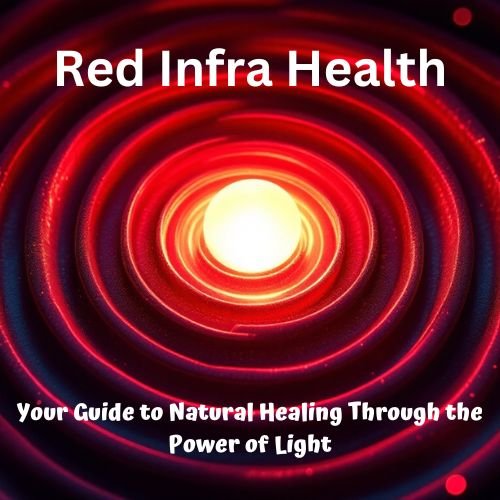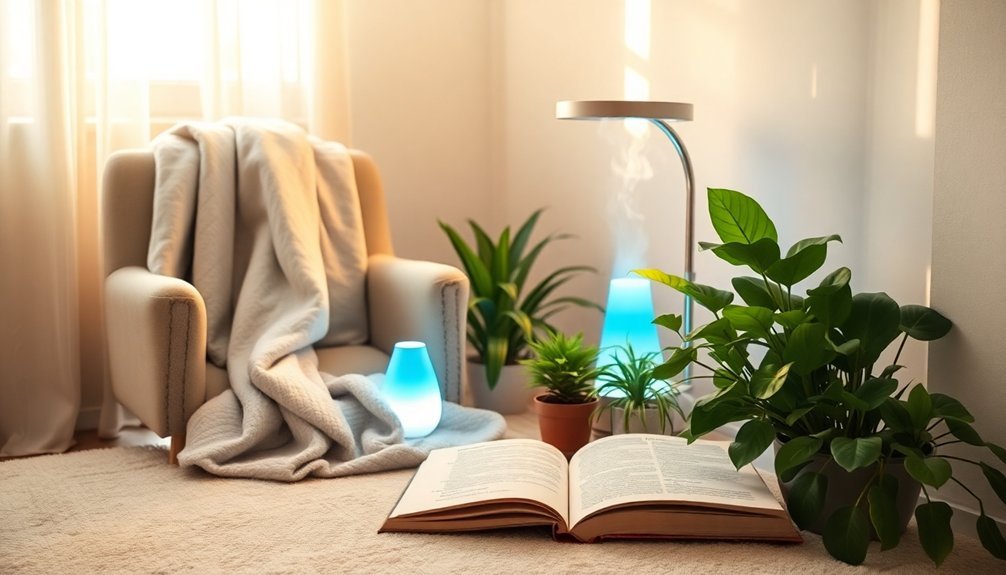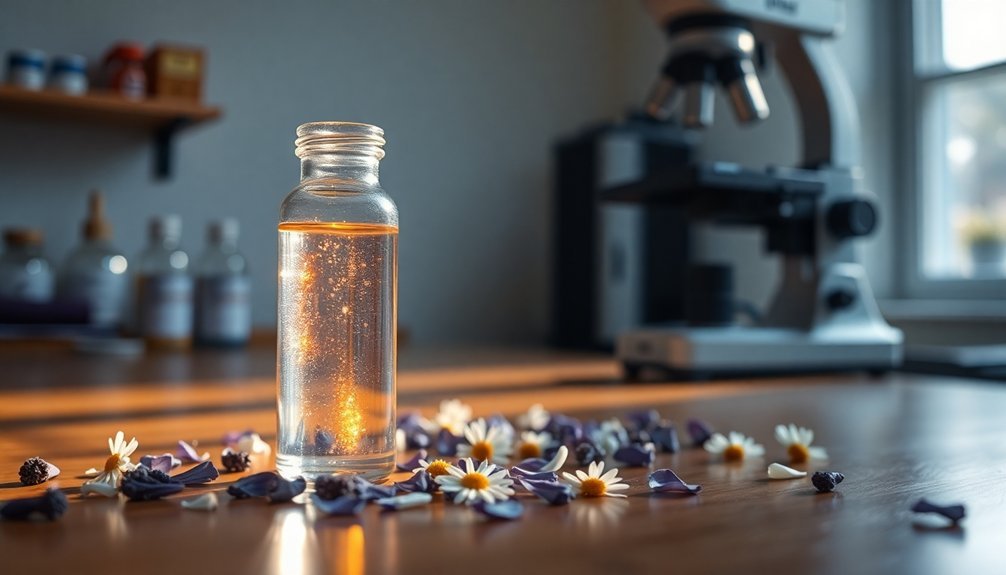Red light therapy boosts your testosterone production by stimulating the Leydig cells in your testicles. When specific wavelengths (660-850 nanometers) of red light hit these cells, they activate your mitochondria – the powerhouses that convert cholesterol into testosterone. You'll get the best results with a combination of visible red light (600-700 nm) and near-infrared light (850 nm), which can increase testosterone levels by up to 200% when applied correctly. The therapy's safe, non-invasive nature makes it an attractive option for natural hormone enhancement. There's much more to understand about this powerful therapy's effects on your hormonal health.
The Science Behind Red Light

While many people associate red light therapy with skin treatments, its effects on testosterone production operate through fascinating biological pathways. When you expose your body to red light, it stimulates specialized cells called Leydig cells, which are responsible for producing testosterone in your testes. The light specifically targets cytochrome c oxidase, a key component in your cells' mitochondria.
Your cells' response to red light therapy is remarkable. The light waves penetrate your tissue and interact with light-sensitive proteins in your testes, triggering a cascade of cellular events. This process enhances ATP production, which is essential for testosterone synthesis. The specific wavelengths of 660 to 850 nanometers have proven most effective for stimulating testosterone production.
Think of it as supercharging your cells' energy factories, giving them the power they need to produce more testosterone efficiently.
The therapy's impact doesn't stop there. It also helps reduce oxidative stress in your cells while improving their overall function. When your Leydig cells are working at peak efficiency, they're better at converting cholesterol into testosterone through a process called steroidogenesis.
This enhanced cellular energy production creates ideal conditions for your body to maintain healthy testosterone levels naturally.
Optimal Wavelengths for Testosterone Production
Understanding specific wavelengths plays a key role in maximizing testosterone production through red light therapy. You'll want to focus on the range of 600-950 nanometers, with particular attention to 660 nm and 850 nm wavelengths. These specific frequencies stimulate ATP production in your Leydig cells, which directly impacts testosterone levels. Photoreceptive proteins in the testicles respond particularly well to these wavelengths, enhancing the hormone production process.
For ideal results, you'll need to combine visible red light (600-700 nm) with near-infrared light (850 nm). This combination therapy can enhance mitochondrial activity in your Leydig cells and boost overall hormone production. Research shows you can potentially double or triple your testosterone levels with consistent application.
| Wavelength | Benefits | Application Time |
|---|---|---|
| 660 nm | Increases ATP Production | 10-15 min |
| 850 nm | Enhances Mitochondrial Activity | 10-15 min |
| 600-700 nm | Boosts Natural T-Levels | 15-20 min |
| 700-850 nm | Improves Cellular Function | 15-20 min |
| Combined Therapy | Maximum T-Production | 10-20 min |
You'll achieve the best results with 10-20 minute sessions, three to four times weekly. Remember to maintain consistency in your treatment schedule and always consult a healthcare professional before starting your red light therapy routine.
Mitochondrial Magic in Leydig Cells

Every testosterone-producing Leydig cell contains numerous mitochondria that serve as powerhouses for steroid hormone production. Within these microscopic structures, a complex process unfolds where cholesterol, the building block of testosterone, must first enter the mitochondria through specialized proteins called STAR and TSPO.
These mitochondria respond directly to signals from luteinizing hormone (LH), which kicks off testosterone production through a chain reaction. When LH binds to receptors on the Leydig cell surface, it triggers an increase in cAMP, activating protein kinase A. This activation helps transport cholesterol into the mitochondria, where it's converted into pregnenolone – the first step in testosterone synthesis.
As you age, your Leydig cells' mitochondrial function often declines, leading to reduced testosterone production even when LH levels remain stable. This decline isn't just about getting older – it's specifically linked to increased oxidative stress and elevated COX-2 levels in aging Leydig cells. The decline typically begins around age 30 in men, affecting various aspects of health and vitality.
Understanding this mitochondrial process helps explain why targeting cellular energy production could be key to maintaining healthy testosterone levels as you age.
Treatment Duration and Frequency
You'll get the best testosterone-boosting results from red light therapy by committing to 10-20 minute sessions, 3-5 times per week.
During your first 4-6 weeks of treatment, you can maximize hormonal benefits by using red light therapy daily or every other day. Using wavelengths between 660-850 nanometers ensures optimal penetration into body tissues for cellular stimulation.
Once you've achieved your desired results, you can switch to a maintenance schedule of 1-3 weekly sessions to keep your testosterone levels balanced.
Optimal Session Schedule
Finding the right schedule for red light therapy is essential for maximizing its testosterone-boosting benefits. You'll want to limit your sessions to 10-20 minutes, as longer exposure won't necessarily yield better results due to cellular saturation. For ideal hormone production, schedule your treatments three to four times per week.
| Duration | Frequency | Benefits |
|---|---|---|
| 10-20 min | 3-4x weekly | Ideal ATP production |
| Under 10 min | Daily | Insufficient stimulation |
| Over 20 min | 1-2x weekly | No added advantage |
The most effective wavelengths for testosterone production fall between 660-850 nm, with 660 nm red light and 850 nm near-infrared light being particularly beneficial for Leydig cell stimulation. These wavelengths penetrate deep enough to reach your testosterone-producing cells while maintaining ideal therapeutic effectiveness.
You can safely combine red light therapy with other testosterone-boosting methods, such as D-aspartic acid or fenugreek supplements, to enhance your results. While the treatment is non-invasive and generally safe, you should consult your healthcare provider before starting, especially if you're taking other supplements or medications for hormone optimization.
Daily Vs Weekly Treatment
Building on ideal session scheduling, understanding the difference between daily and weekly red light therapy treatments can substantially impact your testosterone-boosting results. While you might think more exposure equals better results, daily treatments aren't recommended as they can actually diminish the therapy's effectiveness through overexposure.
Instead, you'll achieve best results by scheduling your sessions three to four times a week, with each session lasting 10-20 minutes. This frequency allows your body's cells, particularly the testosterone-producing Leydig cells, to properly respond to the treatment while maintaining consistent hormonal stimulation.
Your cells need time between sessions to fully utilize the increased ATP production and enhanced mitochondrial activity. When you follow a weekly treatment schedule, you're giving your body the right balance of stimulation and recovery time.
Clinical studies have shown that this approach is more effective than daily exposure for maintaining steady testosterone levels. You'll want to integrate these sessions into a thorough health plan – consider consulting with a healthcare professional to determine how red light therapy can best complement your existing testosterone-boosting strategies.
Clinical Research and Evidence

Laboratory tests consistently show that red light therapy at wavelengths between 600-850 nanometers can boost testosterone levels by up to 200% in some study participants.
You'll find particularly strong evidence in controlled studies measuring both serum testosterone and sperm motility improvements through regular blood work and semen analysis.
The research specifically points to the mid-600s and mid-800s nanometer ranges as most effective for stimulating the Leydig cells that produce testosterone, backed by multiple placebo-controlled trials.
Laboratory Test Results
Recent clinical studies have revealed compelling evidence for red light therapy's effects on testosterone levels. In a groundbreaking 2016 study, men with low sexual desire experienced a significant increase in testosterone levels, jumping from 2.1 ng/ml to 3.6 ng/ml after just two weeks of treatment.
Laboratory tests have confirmed that specific wavelengths between 600-950 nm are most effective at stimulating testosterone production. When researchers examined the biological mechanism, they found that red light therapy activates Leydig cells in the testicles by enhancing ATP energy production.
You'll find this particularly interesting because it's a natural, non-invasive way to boost testosterone levels without harmful side effects.
The University of Siena's placebo-controlled trials have validated these findings, showing consistent results in clinical settings. What's more, laboratory analysis of sperm and testicular tissue has shown no oxidative DNA damage, unlike some other testosterone treatments.
Your body's response to red light therapy isn't just theoretical – it's measurable through standard hormone tests, with studies documenting increases in vital hormones like FSH and LH, which are essential for testosterone production.
Light Wavelength Impact Studies
Clinical research on specific light wavelengths has revealed remarkable precision in targeting testosterone production. Studies show that wavelengths between 600-950 nm effectively boost testosterone levels, with particularly strong results at 670 nm. You'll find that red light therapy can increase your testosterone levels from 2.1 ng/ml to 3.6 ng/ml in just two weeks.
| Wavelength | Impact on Male Health |
|---|---|
| 630 nm | Reduces sperm DNA damage |
| 670 nm | Increases serum testosterone |
| 850 nm | Stimulates Leydig cells |
| 900 nm | Enhances overall testicular function |
The science behind these results is compelling. Red light therapy works by stimulating your Leydig cells, which are responsible for testosterone production. It's also been shown to boost luteinizing hormone (LH) and follicle-stimulating hormone (FSH), both essential for healthy testicular function. You won't have to worry about side effects – research confirms this treatment doesn't cause oxidative DNA damage to your testes or sperm.
While researchers are still uncovering the exact mechanisms, clinical trials consistently demonstrate that red light therapy improves sexual performance and sperm motility through increased testosterone production.
Cellular Energy and ATP Production
Deep within every cell of your body, a remarkable energy production system works tirelessly to generate ATP (adenosine triphosphate), the universal energy currency that powers cellular functions. Your cells consume an astounding 100-150 moles of ATP daily, primarily through processes like muscle contraction, nerve impulse transmission, and chemical synthesis.
When you expose your body to red light therapy, you're directly enhancing this ATP production process. The photons from red or near-infrared light penetrate your cells and stimulate your mitochondria, the powerhouses responsible for creating most of your cellular energy. This stimulation boosts the electron transport chain and breaks nitric oxide bonds, allowing hydrogen ions to move more efficiently through the process.
Your cells produce ATP through several pathways, including glycolysis, the citric acid cycle, and beta-oxidation. For each glucose molecule that enters this system, you'll generate approximately 30 ATP molecules through cellular respiration.
Red light therapy doesn't just enhance existing ATP production—it also triggers mitochondrial biogenesis, creating new mitochondria to increase your overall energy-producing capacity. This improved cellular energy production is essential for ideal testosterone production and overall cellular function.
Red Light Safety Profile

While the cellular benefits of red light therapy are remarkable, understanding its safety profile helps you make informed decisions about treatment. Red light therapy has been extensively tested and approved by health authorities, demonstrating a strong safety record with minimal side effects. Unlike UV rays, red light won't damage your skin or increase cancer risks.
You'll need to take some basic precautions to safeguard safe treatment. Always wear protective goggles to prevent eye strain or damage, and follow recommended exposure times to avoid skin irritation.
If you're taking medications that increase photosensitivity, consult your healthcare provider before starting treatment. Similarly, if you have a history of skin cancer or eye disease, get medical clearance first.
While you can use red light therapy at home, you'll achieve the best results from professional treatments where stronger, medical-grade devices are properly calibrated. Most users experience only mild, temporary effects like slight skin warmth or redness.
The therapy's non-invasive, drug-free nature makes it particularly appealing, and research hasn't found any concerning long-term risks. For best results and safety, work with a qualified professional who can tailor the treatment to your specific needs.
Combining Therapies for Maximum Results
You'll get better results by thoughtfully combining red light therapy with other natural testosterone-boosting methods like vitamin D supplementation and resistance training.
It's important to time these different approaches strategically – for example, using red light therapy after workouts and taking supplements at their best times throughout the day.
When stacking multiple natural methods, always start gradually and monitor your body's response to confirm you're not overwhelming your system with too many changes at once.
Stack Natural Support Methods
Maximizing testosterone support requires a strategic combination of multiple natural interventions working together. You'll get better results when you stack proven methods rather than relying on a single approach.
By combining dietary changes, exercise routines, and targeted supplementation, you're creating a thorough system for hormone optimization.
- Pair resistance training with protein-rich foods like lean beef and fish, aiming for 5-6 ounces daily while incorporating testosterone-boosting exercises like squats and bench presses.
- Combine vitamin D-rich foods (salmon, tuna) with outdoor exercise sessions, maximizing both natural vitamin D production and exercise benefits.
- Stack magnesium-rich foods (spinach, almonds) with zinc sources (oysters) while following a consistent weight training program.
- Integrate pomegranate juice and omega-3 rich foods into your post-workout nutrition while maintaining regular exercise habits.
When you're implementing these combinations, it's essential to maintain consistency and proper timing.
Focus on whole foods first, then add targeted supplements like vitamin D or zinc only if you're deficient.
Remember to avoid harmful factors like BPA exposure and excessive alcohol, as these can undermine your efforts to optimize testosterone levels naturally.
Timing Multiple Treatment Approaches
Building on natural support methods, the strategic timing of red light therapy alongside other testosterone treatments can substantially amplify your results. You'll want to focus on coordinating your treatments to maximize their synergistic effects while maintaining safety.
When you're combining red light therapy with traditional testosterone treatments, aim for consistent exposure times using specific wavelengths of 660nm red light and 850nm near-infrared light. These wavelengths effectively stimulate the photoreceptor proteins in your testes and enhance Leydig cell function, which is essential for testosterone production.
You can expect to see initial effects within 3-4 weeks, though ideal results may take longer. If you're also using growth hormone therapy, you'll likely notice increased lean body mass and strength gains.
Keep your red light therapy sessions brief but regular, as even short exposures can lead to significant testosterone increases.
Monitor your progress carefully, especially if you're using multiple approaches. You'll need to evaluate the percentage rise in your circulating testosterone levels to gauge treatment effectiveness.
Remember that pharmacodynamics can affect how different therapies interact, so work with your healthcare provider to fine-tune the timing of your combined treatments.
Effects on Male Sexual Function

Red light therapy stands out as a groundbreaking solution for male sexual health challenges, targeting both erectile dysfunction and fertility concerns. When you expose your body to red light in the ideal wavelength range of 655-675nm, you'll experience improved blood flow and increased testosterone production, two essential factors for healthy sexual function.
The therapy works by optimizing nitric oxide levels and enhancing mitochondrial function, creating lasting improvements rather than temporary fixes.
For men struggling with fertility issues, red light therapy offers significant benefits by enhancing sperm quality and quantity. You'll find that this non-invasive treatment can boost sperm counts by up to five times while improving motility and reducing abnormal cell production.
- Improves blood circulation naturally without the side effects common in ED medications
- Increases testosterone levels by optimizing hormonal production pathways
- Enhances sperm quality through better Sertoli cell function
- Provides systemic benefits regardless of where the light is applied on your body
The therapy's safety profile makes it an attractive option, as you'll rarely experience side effects beyond temporary redness in the treated area. With FDA-cleared devices available, you can confidently incorporate this treatment into your health routine.
Natural Testosterone Enhancement Methods
While red light therapy offers powerful benefits for testosterone production, you can boost your hormone levels through several natural methods that complement this treatment.
Start by focusing on key nutrients: incorporate zinc-rich foods like oysters and beef, consume fatty fish for vitamin D, and add magnesium-rich foods like spinach and nuts to your diet. You'll also want to guarantee you're getting 5-6 ounces of protein daily from lean sources.
To maximize your body's natural testosterone production, you'll need to make specific lifestyle adjustments. Get 7-8 hours of sleep nightly, as testosterone peaks during rest.
Cut back on alcohol consumption and avoid plastic containers containing BPA, as both can disrupt hormone production. Include regular strength training in your routine, but don't overdo it.
Consider adding proven supplements like ashwagandha and incorporating pomegranate juice into your diet. You'll benefit from following a Mediterranean-style eating pattern while reducing processed foods.
Don't forget to add onions and garlic to your meals – their flavonoids help protect sperm and boost testosterone levels. Remember to manage your stress levels, as high cortisol can interfere with testosterone production.
Red Light Application Techniques

To maximize testosterone production through light therapy, you'll need to target specific wavelengths between 660-850 nanometers for ideal tissue penetration. Exposure sessions should last 10-20 minutes and occur three to four times weekly for superior results.
Research shows you can boost testosterone levels by targeting two primary areas. Chest exposure can increase testosterone by 120% within five days, while genital exposure may boost levels by 200% after eight days.
These impressive results stem from the light's ability to stimulate Leydig cells in the testes and enhance mitochondrial activity.
- Use red light (660 nm) or near-infrared (850 nm) wavelengths for deepest tissue penetration
- Apply light therapy consistently at the same times each week
- Maintain 10-20 minute sessions to prevent overexposure
- Target both chest and genital areas for maximum hormonal response
While red light therapy has proven safe for male genitals with no DNA damage in clinical studies, you'll want to consult a healthcare professional before starting treatment. Combine this therapy with proper diet and exercise for the best results in optimizing your testosterone levels.
Frequently Asked Questions
Can Wearing Red-Tinted Glasses Have Similar Effects on Testosterone Production?
No, wearing red-tinted glasses won't boost your testosterone levels. You need direct red light exposure on your skin, particularly the testicles, to stimulate testosterone production. Visual color perception doesn't affect hormone levels.
Does Red Light Therapy Affect Male Pattern Baldness?
Yes, you'll see significant benefits for male pattern baldness with red light therapy. Clinical studies show it increases hair density, promotes regrowth, and improves thickness. It's proven effective through multiple scientific trials.
Will Red Light Therapy Interfere With Prescription Testosterone Medications?
While red light therapy won't negatively interfere with your prescription testosterone medications, you should consult your doctor before combining them, as the treatments may have synergistic effects that require monitoring your hormone levels.
Can Exposure to Red Christmas Lights Provide Any Testosterone Benefits?
No, Christmas lights won't boost your testosterone. You'll need specific therapeutic wavelengths (660-900nm) and proper intensity levels that regular decorative lights don't provide. Stick to dedicated red light therapy devices instead.
Does Using Red Light Therapy on Specific Body Parts Increase Localized Testosterone?
You'll get the best testosterone benefits by targeting your testicles with red light therapy, as it directly stimulates Leydig cells. While other body parts respond to treatment, the testes show the strongest localized effect.
In Summary
You'll find red light therapy to be a promising natural method for boosting testosterone levels, especially when using the ideal 630-670nm wavelength range. When you combine this treatment with other lifestyle modifications like exercise and proper nutrition, you're likely to see enhanced results. Remember to maintain consistent exposure times and follow recommended protocols to achieve the best outcomes for your hormonal health.





Leave a Reply